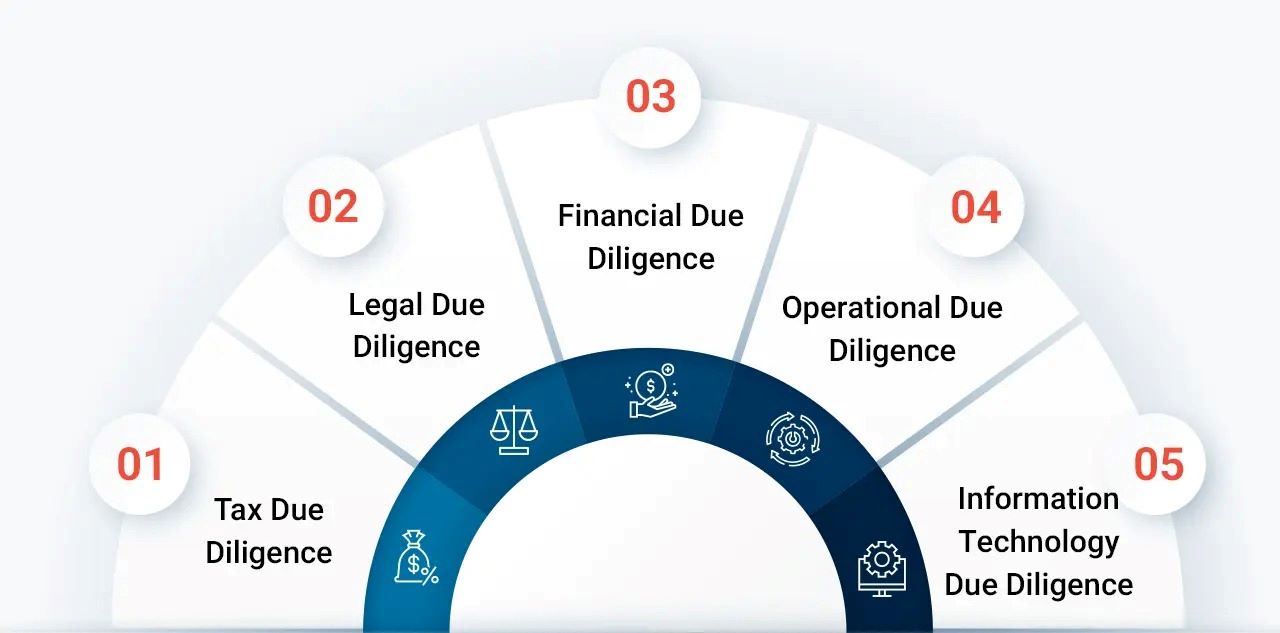

Finance
What Is Due Diligence In M&A
Published: February 23, 2024
Learn about the importance of due diligence in M&A and its impact on finance. Understand the key aspects and best practices for successful M&A transactions.
(Many of the links in this article redirect to a specific reviewed product. Your purchase of these products through affiliate links helps to generate commission for LiveWell, at no extra cost. Learn more)
Table of Contents
Introduction
Mergers and acquisitions (M&A) are pivotal events in the corporate world, often shaping the landscape of industries and markets. However, the process of M&A involves intricate steps and thorough examination to ensure its success. One of the critical components in this process is due diligence.
In the realm of M&A, due diligence serves as the investigative foundation upon which informed decisions are made. It involves a comprehensive assessment and analysis of the target company, encompassing various aspects such as financial, legal, operational, and strategic elements. Essentially, due diligence is the mechanism through which the potential risks, opportunities, and overall health of the target company are meticulously scrutinized.
This article delves into the significance of due diligence in M&A, its types, process, and key considerations. By understanding the nuances of due diligence, both acquirers and target companies can navigate the complexities of M&A with clarity and confidence. Let's embark on this insightful journey to unravel the essence of due diligence in the realm of mergers and acquisitions.
Understanding Due Diligence
Due diligence, in the context of mergers and acquisitions, is a meticulous investigation and analysis process conducted by the acquiring company to evaluate the target company thoroughly. This comprehensive assessment encompasses various facets of the target company, including its financial, legal, operational, and strategic aspects. The primary objective of due diligence is to uncover and evaluate any potential risks, liabilities, or opportunities associated with the target company, enabling the acquiring entity to make well-informed decisions.
Financial due diligence involves a comprehensive review of the target company’s financial records, statements, and performance metrics. This critical aspect aims to assess the accuracy and reliability of the financial information provided by the target company, identify any potential financial risks, and evaluate the overall financial health and performance.
Legal due diligence focuses on examining the legal framework within which the target company operates. This includes scrutinizing contracts, agreements, litigation history, intellectual property rights, and compliance with regulatory requirements. By conducting legal due diligence, the acquiring company aims to identify any legal risks or obligations that could impact the success of the M&A transaction.
Operational due diligence involves assessing the operational aspects of the target company, including its processes, capabilities, supply chain, and potential synergies with the acquiring company. This evaluation helps the acquirer understand the operational strengths and weaknesses of the target company and assess the compatibility of operations post-merger.
Strategic due diligence encompasses an analysis of the strategic fit between the acquiring and target companies. It involves evaluating market positioning, competitive landscape, growth potential, and alignment of business goals. Strategic due diligence aids in determining the synergies, opportunities for expansion, and long-term strategic benefits of the M&A transaction.
By comprehensively understanding due diligence and its multifaceted nature, acquirers can gain valuable insights into the target company, mitigate potential risks, and lay the groundwork for a successful M&A transaction.
Importance of Due Diligence in M&A
Due diligence plays a pivotal role in the success and sustainability of mergers and acquisitions, offering multifaceted benefits to both the acquiring and target companies. One of the primary reasons for the paramount importance of due diligence is risk mitigation. Through a comprehensive examination of the target company’s financial, legal, operational, and strategic aspects, due diligence enables the acquiring company to identify and evaluate potential risks and liabilities. This risk-aware approach empowers the acquiring entity to make informed decisions, mitigate unforeseen challenges, and safeguard its interests.
Furthermore, due diligence serves as a mechanism for uncovering opportunities and synergies. By delving into the intricate details of the target company, acquirers can identify potential areas for growth, operational efficiencies, and strategic alignments. This proactive approach not only enhances the acquirer’s understanding of the target company but also paves the way for leveraging synergies post-merger, thereby maximizing the value and potential of the combined entities.
Transparency and credibility are integral elements of successful M&A transactions, and due diligence facilitates the establishment of these crucial factors. By providing a transparent and comprehensive view of the target company’s financial, legal, and operational landscape, due diligence fosters trust and confidence between the involved parties. This transparency not only enhances the credibility of the M&A transaction but also lays the foundation for a collaborative and harmonious post-merger integration process.
Moreover, due diligence contributes to informed decision-making, enabling the acquiring company to assess the viability and potential return on investment associated with the M&A transaction. By gaining in-depth insights into the target company’s financial performance, market positioning, operational capabilities, and strategic alignment, the acquirer can make well-informed decisions that align with its long-term objectives and growth strategies.
Ultimately, the importance of due diligence in M&A lies in its ability to mitigate risks, uncover opportunities, foster transparency, and facilitate informed decision-making, thereby laying the groundwork for successful and sustainable mergers and acquisitions.
Types of Due Diligence
In the realm of mergers and acquisitions, due diligence encompasses various types, each focusing on specific aspects of the target company. Understanding the different types of due diligence is crucial for conducting a comprehensive assessment of the target company and mitigating potential risks. The primary types of due diligence include financial due diligence, legal due diligence, operational due diligence, and strategic due diligence.
- Financial Due Diligence: This type of due diligence involves a meticulous review and analysis of the target company’s financial records, statements, and performance metrics. The primary objective is to assess the accuracy and reliability of the financial information provided by the target company, identify potential financial risks, and evaluate the overall financial health and performance.
- Legal Due Diligence: Legal due diligence focuses on examining the legal framework within which the target company operates. This includes scrutinizing contracts, agreements, litigation history, intellectual property rights, and compliance with regulatory requirements. The aim is to identify any legal risks or obligations that could impact the success of the M&A transaction.
- Operational Due Diligence: Operational due diligence involves assessing the operational aspects of the target company, including its processes, capabilities, supply chain, and potential synergies with the acquiring company. This evaluation helps the acquirer understand the operational strengths and weaknesses of the target company and assess the compatibility of operations post-merger.
- Strategic Due Diligence: Strategic due diligence encompasses an analysis of the strategic fit between the acquiring and target companies. It involves evaluating market positioning, competitive landscape, growth potential, and alignment of business goals. This type of due diligence aids in determining the synergies, opportunities for expansion, and long-term strategic benefits of the M&A transaction.
By recognizing and engaging with these distinct types of due diligence, acquiring companies can conduct a comprehensive assessment of the target company, identify potential risks and opportunities, and make informed decisions that align with their strategic objectives and growth aspirations.
Due Diligence Process
The due diligence process in mergers and acquisitions is a structured and systematic approach that involves a series of steps aimed at comprehensively evaluating the target company. This process typically begins after the initial stages of negotiation and preliminary agreement between the acquiring and target companies. The due diligence process can be outlined as follows:
- Preparation and Planning: The acquiring company assembles a due diligence team comprising professionals from various disciplines such as finance, legal, operations, and strategy. A detailed plan is formulated, outlining the scope, objectives, and timeline of the due diligence process.
- Information Gathering: The acquiring company requests and collects a wide range of documents and information from the target company, including financial statements, contracts, legal documents, operational reports, and strategic plans. This phase requires meticulous attention to detail and may involve multiple rounds of information requests.
- Document Review and Analysis: The gathered information is meticulously reviewed and analyzed by the due diligence team. Financial records are scrutinized, legal documents are examined for potential risks and obligations, operational reports are assessed for efficiency and scalability, and strategic plans are evaluated for alignment with the acquiring company’s objectives.
- On-Site Visits and Interviews: In many cases, the due diligence process includes on-site visits to the facilities of the target company. This provides an opportunity for the acquiring company’s team to conduct interviews with key personnel, observe operations firsthand, and gain a deeper understanding of the target company’s culture and capabilities.
- Risk Assessment and Mitigation: Throughout the process, the due diligence team identifies potential risks, liabilities, and opportunities associated with the target company. Risk mitigation strategies are developed, and the impact of these risks on the M&A transaction is carefully assessed.
- Reporting and Decision-Making: The findings and insights derived from the due diligence process are compiled into a comprehensive report. This report forms the basis for informed decision-making, guiding the acquiring company in determining the viability and terms of the M&A transaction.
By adhering to this structured due diligence process, acquiring companies can conduct a thorough assessment of the target company, mitigate risks, and make well-informed decisions that align with their strategic objectives and growth aspirations.
Due Diligence Checklist
A comprehensive due diligence checklist serves as a vital tool for acquiring companies, guiding them through the intricate process of evaluating a target company in the context of mergers and acquisitions. While the specific items on the checklist may vary based on industry, size, and nature of the transaction, the following elements are commonly included in a due diligence checklist:
- Financial Documents: This category encompasses financial statements, tax returns, budget forecasts, accounts receivable and payable, cash flow statements, and debt obligations. Thoroughly reviewing these documents provides insights into the target company’s financial health and performance.
- Legal and Compliance: Legal documents, contracts, licenses, permits, litigation history, intellectual property rights, and regulatory compliance records fall under this category. Assessing the legal and compliance aspects helps in identifying any potential legal risks or obligations.
- Operational and Technical: Operational reports, production processes, supply chain management, technology infrastructure, and inventory management systems are crucial components. Understanding the operational and technical aspects aids in evaluating the efficiency and scalability of the target company’s operations.
- Strategic Planning and Market Positioning: Strategic plans, market analyses, competitive landscape assessments, and growth projections provide valuable insights into the target company’s strategic positioning and potential for expansion.
- Human Resources and Organizational Structure: Employee contracts, organizational charts, HR policies, and employee benefit plans are essential for understanding the target company’s workforce and organizational dynamics.
- Customer and Supplier Relationships: Evaluating customer contracts, sales data, and supplier agreements offers insights into the strength of customer relationships and the stability of the supply chain.
- Real Estate and Assets: Property deeds, asset inventories, and leases are critical for assessing the target company’s real estate holdings and asset base.
- Environmental and Sustainability Factors: Environmental impact assessments, sustainability initiatives, and compliance with environmental regulations are increasingly important considerations in due diligence checklists.
By meticulously addressing the items on a due diligence checklist, acquiring companies can conduct a comprehensive assessment of the target company, uncover potential risks and opportunities, and make well-informed decisions that align with their strategic objectives and growth aspirations.
Key Considerations in Due Diligence
As acquiring companies embark on the due diligence process in the context of mergers and acquisitions, several key considerations emerge as pivotal focal points for a comprehensive assessment of the target company. These considerations encompass critical aspects that can significantly impact the success and sustainability of the M&A transaction. The following key considerations are integral to the due diligence process:
- Quality of Earnings: Assessing the quality of the target company’s earnings involves scrutinizing the consistency, sustainability, and accuracy of its financial performance. This evaluation provides insights into the underlying factors driving the company’s profitability and identifies any potential discrepancies or irregularities.
- Regulatory and Legal Compliance: Ensuring the target company’s adherence to regulatory requirements and legal obligations is crucial for mitigating legal risks and liabilities. This consideration involves examining compliance with industry-specific regulations, intellectual property rights, and any ongoing or potential litigation.
- Operational Efficiency and Scalability: Understanding the operational processes, capabilities, and scalability of the target company is essential for assessing its potential for growth and integration post-merger. Evaluating operational efficiency aids in identifying opportunities for streamlining processes and optimizing performance.
- Market Positioning and Competitive Landscape: Analyzing the target company’s market positioning, competitive advantages, and industry dynamics provides valuable insights into its strategic relevance and growth potential. This consideration aids in determining the alignment of business goals and the potential for market expansion.
- Human Capital and Organizational Culture: Assessing the target company’s workforce, talent management practices, and organizational culture is critical for understanding the human capital dynamics and potential challenges in post-merger integration.
- Synergies and Integration Challenges: Identifying potential synergies between the acquiring and target companies, as well as anticipating integration challenges, is essential for planning a seamless post-merger integration process. This consideration involves evaluating compatibility in operations, technologies, and corporate cultures.
- Risks and Contingencies: Thoroughly assessing and quantifying potential risks, including financial, operational, and market-related risks, enables the acquiring company to develop risk mitigation strategies and contingency plans.
By prioritizing these key considerations in the due diligence process, acquiring companies can gain comprehensive insights into the target company, mitigate potential risks, and strategically plan for a successful and harmonious merger and integration process.
Conclusion
The process of due diligence in mergers and acquisitions is a fundamental undertaking that shapes the trajectory and outcomes of these transformative business transactions. By delving into the multifaceted layers of due diligence, acquiring companies gain invaluable insights into the target company’s financial, legal, operational, and strategic landscape. This comprehensive understanding not only mitigates potential risks but also uncovers opportunities for growth, synergies, and long-term value creation.
Throughout the due diligence journey, the emphasis on risk mitigation, transparency, and informed decision-making resonates as pivotal themes. Acquiring companies meticulously assess the quality of earnings, regulatory compliance, operational efficiency, market positioning, human capital dynamics, and integration challenges. These key considerations form the bedrock upon which strategic decisions are made, ensuring that the M&A transaction aligns with the acquirer’s growth objectives and long-term sustainability.
Furthermore, the due diligence checklist serves as a guiding compass, directing the thorough examination of financial documents, legal and compliance aspects, operational and technical facets, strategic planning, human resources, customer and supplier relationships, real estate holdings, and environmental considerations. By meticulously addressing each item on the checklist, acquiring companies navigate the due diligence process with precision and diligence, laying the groundwork for a seamless and successful M&A transaction.
As the due diligence process unfolds, the collaborative efforts of cross-disciplinary teams, on-site visits, document analyses, and risk assessments culminate in the compilation of a comprehensive report. This report, infused with insights and recommendations, forms the cornerstone for informed decision-making, enabling acquiring companies to proceed with confidence and clarity.
In conclusion, due diligence in M&A transcends beyond a mere investigative exercise; it embodies the essence of strategic foresight, risk management, and value creation. By embracing the intricacies of due diligence, acquiring companies navigate the complexities of M&A with resilience and vision, paving the way for sustainable growth, synergistic integration, and enduring success in the corporate landscape.














